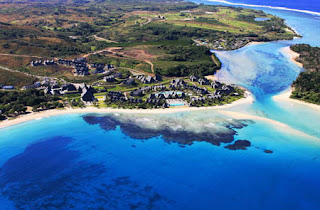Man vs. Mangrove
Unlike most other organisms, humans do not exist within
their environment without inflicting some form of damage to their surroundings.
Fiji is no exception, however, indigenous Fijians have historically lived in
unison with the mangrove forests until recent increases in development.
Humans pose many threats to the long-term sustainability of
the Fijian mangrove ecosystem. Fiji is a net exporter of a variety of wood
products; mangrove wood is highly valued for its durability and hardness. In
recent years, timber companies such as Fiji Hardwood Corporation Limited, an
employer of around one hundred Fijians, have cut mangrove forests along the
southern coast of the Fijian mainland island Viti Levu.
(InterContinental Fiji Golf Resort and Spa)
 Mangroves are often reclaimed and
turned into agricultural areas or developed for urban expansion. Sugarcane is
grown in many parts of Fiji because the islands receive subsidies from the EU
for sugar production. Agriculture activity in inland areas trickle down to
negatively effect the mangrove forests. As sediment is uprooted and mixed into
local waterways, sediment alters the hydrological regime of mangrove
populations. The trees are evolutionary designed to fulfill their ecological
role without the interference of sediment interference in their waters. In the
Malaysian peninsula, shrimp farming within mangrove beds has been one of the
main sources of destruction of the natural environment, however it is
noteworthy to mention that shrimp production is not nearly such an issue in
Fiji. (Agrawala pg. 39)
Mangroves are often reclaimed and
turned into agricultural areas or developed for urban expansion. Sugarcane is
grown in many parts of Fiji because the islands receive subsidies from the EU
for sugar production. Agriculture activity in inland areas trickle down to
negatively effect the mangrove forests. As sediment is uprooted and mixed into
local waterways, sediment alters the hydrological regime of mangrove
populations. The trees are evolutionary designed to fulfill their ecological
role without the interference of sediment interference in their waters. In the
Malaysian peninsula, shrimp farming within mangrove beds has been one of the
main sources of destruction of the natural environment, however it is
noteworthy to mention that shrimp production is not nearly such an issue in
Fiji. (Agrawala pg. 39)
As the tourism industry in Fiji booms,
developers have come face to face with mangroves, and the decision usually
favors the money. When I traveled to Fiji in the summer of 2011, I stayed at a
large coastal resort called the Intercontinental. As I walked down the coastline
surrounding the 5 star resort, I eventually came across mangroves growing in
shallow water along the beach. Off shore of the mangrove trees, I could walk
about two miles into the ocean on top of knee-deep coral reef. The reefs served
as a barrier for the mangrove colony, and the trees provided the ecological
services necessary to clean sediment out of runoff, and serve as breeding
grounds for tropical reef fish. I imagine that the construction of my luxurious
resort resulted in the deaths of multiple mangrove trees.
___________________________________________________________________
Agrawala, Shardul, et
al. "Development and Climate Change in Fiji: Focus on coastal
mangroves." Environment Directorate and Development Cooperation
Directorate, Organisation for Economic Cooperation and Development (OECD),
Paris (2003).
"InterContinental Fiji Golf Resort and Spa - Natadola, Coral Coast, Fiji." InterContinental Fiji Golf Resort and Spa, Nadi : Five Star Alliance.
N.p., n.d. Web. 25 Nov. 2012.
<http://www.fivestaralliance.com/luxury-hotels/nadi/intercontinental-fiji-golf-resort-and-spa/gallery/show>.

No comments:
Post a Comment